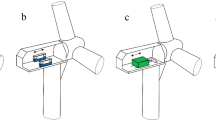Abstract
In this paper, vibration characteristics of the structure in the finite fluid domain are analyzed using a coupled finite element method. The added mass matrix is calculated with finite element method (FEM) by 8-node acoustic fluid elements. Vibration characteristics of the structure in finite fluid domain are calculated combining structure FEM mass matrix. By writing the relevant programs, numerical analysis on vibration characteristics of a submerged cantilever rectangular plate in finite fluid domain and loaded ship model is performed. A modal identification experiment for the loaded ship model in air and in water is conducted and the experiment results verify the reliability of the numerical analysis. The numerical method can be used for further research on vibration characteristics and acoustic radiation problems of the structure in the finite fluid domain.
Similar content being viewed by others
References
Ahlem A (2004). Simulation of vibro-acoustic problem using coupled FE/FE formulation and modal analysis. ASME/JSME 2004 Pressure Vessels and Pi** Conference, San Diego, USA, 147–152. DOI: 10.1115/PVP2004-2865
Atalla N, Bernhard RJ (1994). Review of numerical solutions for low-frequency structural-acoustic problems. Applied Acoustic, 43(3), 271–294. DOI: 10.1016/0003-682X(94)90050-7
Chen Gang, Zhang Shengkun, Wen Changjian (1999). Experiment of fluid-structure interaction vibration of bottom panel of box-shaped ship model. Ship Engineering, (4), 13–14. (in Chinese)
Chen Meixia, Luo Dong**, Cao Gang, Cai Minbo (2003). Analysis of vibration and sound radiation from ring-stiffened cylindrical shell. Journal of Huazhong University of Science and Technology (Nature Science Edition), 31(4), 102–104. (in Chinese) DOI: 10.13245/j.hust.2003.04.035
Coyette JP, Fyfe KR (1989). Solution of elasto-acoustic problems using a variational finite element boundary element technique. Proceedings of Winter Annual Meeting of the ASME, San Fransisco, USA, 15–25.
Everstine GC (1991). Prediction of low-frequency vibrational frequencies of submerged structures. Journal of Vibration and Acoustics–Transactions of the ASME, 113(2), 187–191. DOI: 10.1115/1.2930168
Everstine GC (1997). Finite element formulations of structural acoustics problems. Computers & Structures, 65(3), 307–321. DOI: 10.1016/S0045-7949(96)00252-0
Everstine GC, Henderson FM (1990). Coupled finite-element boundary-element approach for fluid structure interaction. Journal of the Acoustical Society of America, 87(5), 1938–1947. DOI: 10.1121/1.399320
Gladwell GML (1966). A variational formulation of damped acousto-structural vibration problems. Journal of Sound and Vibration, 4(2), 172–186. DOI: 10.1016/0022-460X(66)90120-9
Jeans RA, Mathews IC (1990). Solution of fluid-structure interaction problems using a coupled finite-element and variational boundary element technique. Journal of the Acoustical Society of America, 88(5), 2459–2466. DOI: 10.1121/1.400086
Liu Cheng, Hong Ming, Liu **aobing (2014). The solution for vibration characteristics of submerged plates by applying FEM/ IBEM. Journal of Harbin Engineering University, 35(4), 395–400. (in Chinese) DOI: 10.3969/j.issn.1006-7043.201303052
Lu **nsen, Clough RW (1982). A hybrid substructure approach for analysis of fluid-structure interaction in ship vibration. Journal of Vibration and Shock, 1, 17–27. (in Chinese)
Petyt M, Lea J, Koopmann GH (1976). A finite-element method for determining acoustic modes of irregular shaped cavities. Journal of Sound and Vibration, 45(4), 495–502. DOI: 10.1016/0022-460X(76)90730-6
Thompson LL (2005). A review of finite-element methods for time-harmonic acoustics. Journal of the Acoustical Society of America, 119(3), 1315–1330. DOI: 10.1121/1.2164987
Tong Yu**g, Liu Zhengxing (1997). The Additional water mass in solid-liquid coupling problem by FEM. Shanghai Journal of Mechanics, 18(4), 311–320 (in Chinese)
Vlahopoulos N, Raveendra ST, Vallance C, Messer S (1999). Numerical implementation and applications of a coupling algorithm for structural-acoustic models with unequal discretization and partially interfacing surfaces. Finite Elements in Analysis and Design, 32(4), 257–277. DOI: 10.1016/S0168-874X(99)00008-6
Volcy GC, Morel P, Bureau M, Tanida K (1979). Some studies and researches related to the hydro-elasticity of steel work. Proceedings of the 122nd Euromech Colloquium on Numerical Analysis of the Dynamic of Ship Structures, Paris, France, 403–406.
Wang **angbao, Han Jiwen, Lu **nsen (1988). Fluid-structure coupled vibration of cantilever plates and continuous plates. Shipbuilding of China, 16, 53–63. (in Chinese) DOI: 10.13465 /j.cnki.jvs.1985.04.002
Wang Zheng, Hong Ming, Liu Cheng (2014). Domestic review of the submerged structure vibration and acoustic radiation characteristics based on FEM/BEM. Journal of Ship Mechanics, 18(11), 1397–1414. (in Chinese)
Wei Jianhui, Chen Meixia, Mou Zhijie, Qiao Zhi (2011). Research on vibroacoustic characteristic of double cylinder shell underwater based on IBEM. Ship Science and Technology, 33(7), 9–13, 21. (in Chinese) DOI: 10. 3404/j.issn.1672-7649.2011.07.002
Wu Fang, Zhao Deyou (2007). Effect of water on the ship and ocean engineering structure. China Offshore Platform, 22(3), 22–26 (in Chinese)
Yao **ongliang, Qian De**, Zhang Yan (2006). Numerical analysis method for sound radiation of underwater structure in time domain. Chinese Journal of Ship Research, 11(5-6), 30–35. (in Chinese)
Yao **ongliang, Yang Nana, Tao **gqiao (2004). Numerical research on vibration and sound radiation of underwater double cylindrical shell. Journal of Harbin Engineering University, 25(2), 136–140. (in Chinese)
Zhao Guanjun, Liu Geng, Wu Liyan (2007). Simulation and experiment on coupled vibro-acoustic noise using modal superposition method. Mechanical Science and Technology for Aerospace Engineering, 26(12), 1633–1636.
Zheng Zhiguo, Sun Dacheng, Liu **anliang (1998). A Study on the fluid-structure interaction with wet model. Journal of North China Institute of Water Conservancy and Hydroelectric Power, 19(2), 22–25. (in Chinese)
Author information
Authors and Affiliations
Corresponding author
Additional information
Foundation item: Supported by the National Natural Science Foundation of China (No. 51079027).
Rights and permissions
About this article
Cite this article
Liang, P., Hong, M. & Wang, Z. Experimental and numerical investigations on vibration characteristics of a loaded ship model. J. Marine. Sci. Appl. 14, 234–243 (2015). https://doi.org/10.1007/s11804-015-1310-1
Received:
Accepted:
Published:
Issue Date:
DOI: https://doi.org/10.1007/s11804-015-1310-1




